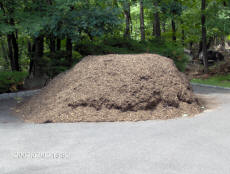RIKLBLOG
|
| Tomorrow |
| 05 July 2007 |
| Yesterday |
| Index |
| Eventide |
| SETI League |
| PriUPS Project |
| Bonus! |
| Contact |
Mulch Madness - The Winner!
Q: Why is a straw hat like a kiss on the
telephone?
A: Because it isn't felt.
On 03 July I wrote a blogitem as the lead up to the the declaration of the winner of the Mulch Madness Contest. Yesterday, The Fourth of July, in addition to holding my annual BBQ party for friends (food) and their small human children (a pool with a deep end if necessary), I measured, to the best of my ability, the remanent heap'o'mulch so that a winner might be declared. Today I reduce the measurement to cubic furlongs, compare this official datum with the entries, and declare a winner.
The Prize
After much reflection, I selected a suitable prize. The criteria were:
-
It had to be funny.
-
It had to be worth something. A do-it-yourself bag of mulch, especially after it rained at the party, wouldn't do.
-
It could not require "shopping." I've had my fill of that for the year.
The Mulch Pile Itself
Volumetric measurement of an uncontained mulch heap does not lend itself to great precision. I have no large container of standard volume, and even if I did, I would have no easy way of packing it with mulch. Attempting to weigh the mulch would be futile even if I had the apparatus, as it varies strongly by water absorption. Accordingly, I unlimbered a tape measure and assessed the heap's dimensions as best I could. I had help and witnesses, lest the losers accuse me of manipulating the results. I managed to destroy the tape measure in the process of determining the circumference of the pile. This was not pique caused by my inability to find a tape measure calibrated in furlongs. As I reached its end it was done in by a simple twist of tape.
 |
As you can see, the heap is somewhat conical in shape, but not axisymmetric as would be expected from a proper cone. I took the following measurements in inches (furlongs):
|
For an initial approximation, I calculated the volume (V) assuming it was the frustum of an axisymmetric cone (V = 0.2618*h*(D^2+D*d+d^2))
V = .2618 * 44 * (23716 + 11858 + 5929) = 478,000 cubic inches or 9.62*10-7 cubic furlongs.
The Entries Considered
1/4 heap: I left this one in because it was valid, but it's clear by inspection that the 1.3 cubic Prii response is closer, so this loses by comparison.
3.6 billion thimblefuls: Here we have a dilemma. How many cubic furlongs is a thimble? Metric thimble or English? The entrant didn't specify. Equally problematic, mulch is a granular, largely scale-free material, and if one actually tried to measure its volume by thimble, he would find that a large proportion would not fit in the "instrument." We investigate further and find in the first line of the very first Googled item states "There are no standard thimble sizes." In addition to the common thimble used for sewing, "thimble" is a term of art in scientific fields and I've found references of 1.5ml to 120ml, a volume ratio of almost 100 to one. I contacted the entrant requesting disambiguation but received only silence. In good conscience, then, I must discount this entry since the 1/4-heap entry is by definition off by no more than 4 to 1, and actually somewhat less.
75.7 cubic cubits: Finally one for which I don't have to think. Google says "75.7 (cubic cubits) = 8.88664538 × 10-7 cubic furlongs", which differs from my own fairly imprecise measurement by less than 10%.
1.3 cubic Prii: This entry would be a potential winner since the heap'o'mulch and the car are at least similar in scale. The official Prius dimensions are (Height/Width/Length) 58.1"*67.9"*175.0", or 1.389*10^-6 cubic furlongs if it were truly rectangular. Multiply this by 1.3 as the entry specifies to get 1.806*10^-6 cubic furlongs, which is roughly twice the actual mulch measurement. This forces one to answer the question of whether there is enough non-rectangularity to a Prius to account for about half the volume of the space it would occupy were it rectangular. Carl Zeiss Inc. manufactures coordinate tracing machines that, along with some complicated mathematics and a computer, can determine the volume of irregular objects. I don't own one. I could have carefully sealed all the Prius openings, placed it in the pool, and measured its displacement. Unfortunately I ran out of silicone sealant before I could even finish all the doors, much less the trunk and engine compartment, so I decided to eschew this option. I could possibly call Toyota on the telephone and find their design department and ask them, but I don't speak Japanese and hate the telephone. Even worse, this would be research. I finally decided to look at the Prius and at the mulch pile and at the Prius and at the mulch pile and... When I was done, I concluded that the 1.3 Prii estimate, albeit a very reasonable one, is probably about 50% high, while the 765.7 cubic cubits answer is only 10% low.
Given the disparity between the other answers and the closest one, I thankfully decided that I didn't need to refine my measurement to account for the lack of symmetry.
The Winner
 |
Accordingly, it is my pleasure to award the prize to "Rick." who, as you will see from his entry, is clearly a nerd. Although I observe only one pen in his pocket, I'm sure he's qualified for two or perhaps even three. Where are they? Maybe he ignored his invitation to meet The Board, or perhaps he attended the party incognito. I had Rick and another entrant separately pose with the prize, although it had not been officially awarded yet. It has been now, and I shall send it to him. By odd coincidence, Joan, Rick's straw-hatted companion for the day, left that hat at my house, and I shall return it to her in the same package as the prize, which is an exploding penguin for the television set. I neglected to ask Rick if he even has a television set. I wouldn't care to speculate either way. And I swear that my judging of the entries was not in any way swayed by the fact that awarding it to Rick would save me postage.
|
The Entry
I have printed this verbatim, with no editing other than font and line-length changes. THIS is how you enter a mulch-pile-estimation contest. Good work, Rick!
The pictured mulch pile is described as having the footprint of a car.
Given
the shovel in the picture, it appears to be a small car. Going to the
Internet (you can find pretty much anything on the Internet) we find the
dimensions of a VW Beetle as 4.08m by 1.72m by 1.50 m. Moving to more
familiar measurements, we get 8.93 cubits by 3.77 cubits by 3.28 cubits.
With some correction to account for the fact that neither the mulch pile
nor
the VW Beetle are true rectangular parallelepipeds, we get an initial
estimated mulch volume of 82.81861 cubic cubits (use of Excel permits
extreme
precision if not extreme accuracy).
Now we need to consider the actions which may reduce the size of the
mulch
pile before July 4:
Gravitational compression will certainly occur, though it is a fairly
slow
process.
Additional compression may occur if there is rainfall before July 4.
If there is wind, particularly wind without rain, some of the mulch will
blow
away.
And finally, if perhaps least likely, some wheelbarrow loads of mulch
may
actually be removed to the garden.
We examine each of these factors.
The pile will settle over time. While measures of mulch density are
available
on the Internet (unfortunately they range from "near 0" kg/m3
[see
this article]
to 33kg/m3 so
they are of minimal practical use), values for mulch's resistance
to
compression forces were not immediately available. Since the mulch pile
is
new and thus loosely packed, we assume compression of about 1 inch
1/18 cubit
per
week. So over the three weeks until July 4, the pile looses 3/18 (= 0.167)
cubits in height (other dimensions are not significantly affected by
gravity).
While rainfall data for Kinnelon were not immediately available,
Morristown's
average rainfall in June is 0.228 cubits. Correcting for three weeks
instead
of the entire month gives 0.159 cubits of rain. We estimate that this
will
cause another 0.11 cubits of height loss.
Wind data is scarce. However, there is a 1:200 chance of a hurricane
hitting
New Jersey (the Internet again). June is not a common month for
hurricanes;
only 6.5% of hurricanes that hit New Jersey occur in June. So overall,
there
is a 0.03% chance of a hurricane affecting the mulch pile. Of course, in
the
unlikely event of a hurricane the mulch pile would be significantly
affected,
likely losing 50% or more of its volume. So the hurricane effect is
estimated
at 0.03% x 50% x 82.81861 cubic cubits, or 0.013 cubic cubits.
If any of the mulch is actually used, it will be removed from the pile
by
wheelbarrow. The volume of a typical wheelbarrow is 170 liters (the
Internet
seems fixated on metric units for some reason). This comes to 19.3 pecks
or
1.78 cubic cubits. While reports indicate that the hostal units have
actually
removed some mulch from the pile to date, we must consider the time
demands of
party preparations in the coming weeks. We estimate the probability of
mulch
removal via the wheelbarrow mechanism at 5%, so the contribution is
0.089
cubic cubits.
All together, this gives an estimate for final July 4 mulch volume of
75.72247
cubic cubits.
NP: "Runaway" - Marillion
| © 2007 |
| Richard Factor |
